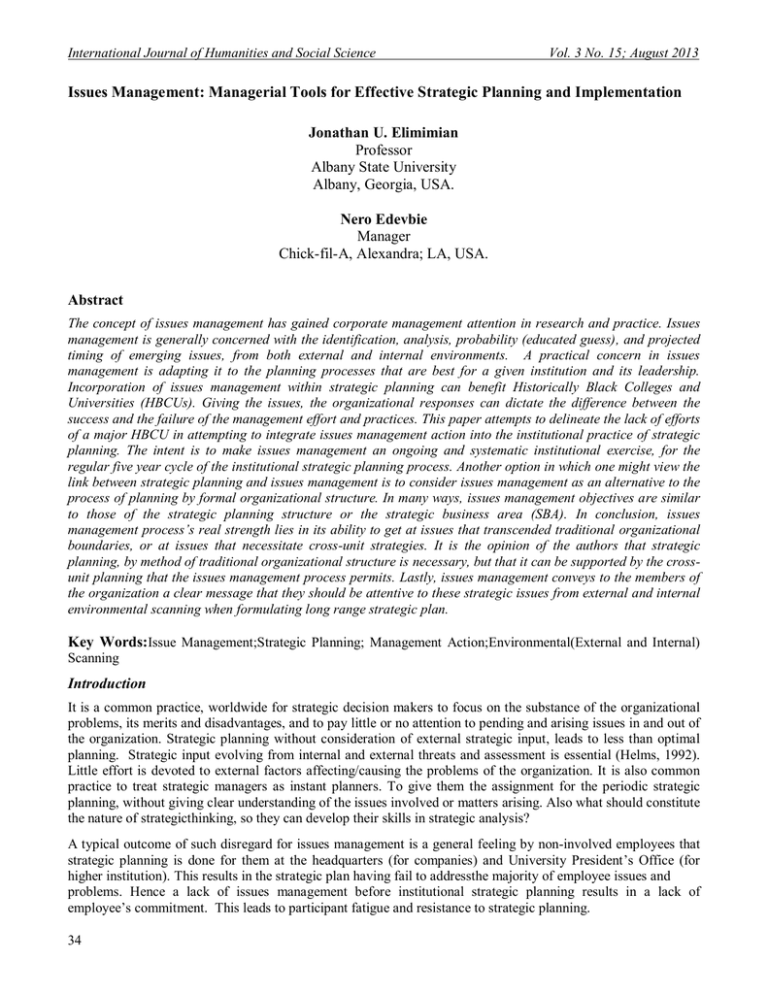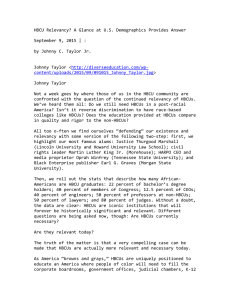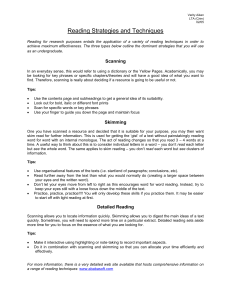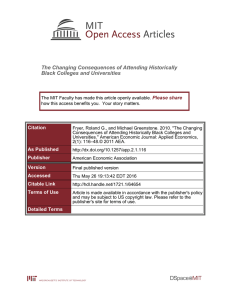Document 10465249
advertisement

International Journal of Humanities and Social Science Vol. 3 No. 15; August 2013 Issues Management: Managerial Tools for Effective Strategic Planning and Implementation Jonathan U. Elimimian Professor Albany State University Albany, Georgia, USA. Nero Edevbie Manager Chick-fil-A, Alexandra; LA, USA. Abstract The concept of issues management has gained corporate management attention in research and practice. Issues management is generally concerned with the identification, analysis, probability (educated guess), and projected timing of emerging issues, from both external and internal environments. A practical concern in issues management is adapting it to the planning processes that are best for a given institution and its leadership. Incorporation of issues management within strategic planning can benefit Historically Black Colleges and Universities (HBCUs). Giving the issues, the organizational responses can dictate the difference between the success and the failure of the management effort and practices. This paper attempts to delineate the lack of efforts of a major HBCU in attempting to integrate issues management action into the institutional practice of strategic planning. The intent is to make issues management an ongoing and systematic institutional exercise, for the regular five year cycle of the institutional strategic planning process. Another option in which one might view the link between strategic planning and issues management is to consider issues management as an alternative to the process of planning by formal organizational structure. In many ways, issues management objectives are similar to those of the strategic planning structure or the strategic business area (SBA). In conclusion, issues management process’s real strength lies in its ability to get at issues that transcended traditional organizational boundaries, or at issues that necessitate cross-unit strategies. It is the opinion of the authors that strategic planning, by method of traditional organizational structure is necessary, but that it can be supported by the crossunit planning that the issues management process permits. Lastly, issues management conveys to the members of the organization a clear message that they should be attentive to these strategic issues from external and internal environmental scanning when formulating long range strategic plan. Key Words:Issue Management;Strategic Planning; Management Action;Environmental(External and Internal) Scanning Introduction It is a common practice, worldwide for strategic decision makers to focus on the substance of the organizational problems, its merits and disadvantages, and to pay little or no attention to pending and arising issues in and out of the organization. Strategic planning without consideration of external strategic input, leads to less than optimal planning. Strategic input evolving from internal and external threats and assessment is essential (Helms, 1992). Little effort is devoted to external factors affecting/causing the problems of the organization. It is also common practice to treat strategic managers as instant planners. To give them the assignment for the periodic strategic planning, without giving clear understanding of the issues involved or matters arising. Also what should constitute the nature of strategicthinking, so they can develop their skills in strategic analysis? A typical outcome of such disregard for issues management is a general feeling by non-involved employees that strategic planning is done for them at the headquarters (for companies) and University President’s Office (for higher institution). This results in the strategic plan having fail to addressthe majority of employee issues and problems. Hence a lack of issues management before institutional strategic planning results in a lack of employee’s commitment. This leads to participant fatigue and resistance to strategic planning. 34 © Center for Promoting Ideas, USA www.ijhssnet.com Therefore, these authors refer to the issues management as the beginning process of strategic planning and as a process of building and implementation ability into the strategic planning document. Both authors have been actively involved in teaching, learning and studying the strategic planning for a Historically Black College and University (HBCU) for the past decade. From our studies and observations, the HBCU studied did not apply issues management rubric in any of the strategicplanning documents. Our purpose in this paper is to offer some insight into the significance of issues management as management guide for the home institution, towardsfuture strategic planning process. Operational Definitions of Terms Used in the Paper: We start with an operational definition of issues management. Issue(s) comes from either inside or outside of the organization. These issues are likely to have an impact on the ability or inability of the business to meet its goals and objectives. An issue may be an opportunity or threat from either external or internal environment (Ansoff; 1991 and see Figure1 below). Most often, external issues that comeinform of threats could be converted into opportunities by aggressive strategy and entrepreneurial management skills. On the other hand, internal weakness of issues(such as lack of capabilities) often leads to lack of continuing success. Since management is often strategically overloaded, that justifies why these authors suggest reviews and updates of organizational strategic issues every five years. In the same order, strategic planning are reviewed and revisedin every five year cycle. The reviews are based on the analysis of the current emerging issues to establish their relevance to the organization and the likelihood of their impact on job performance, University curriculum update and the development of appropriate organizational response to these issues through the new strategic planning templates. In addition, the University issues management process will always remain one component of the five year cycle of the strategic management process for the University (HBCU focus). These termsimplies that there are several stages in the issues management process: (1) scanning the external and internal environment to identify strategic issues: (2) analyzing these issues for their likely impact and probability of occurrence; and (3) developing suitable responses for managing the issues. As with most organizational science concepts (e.g., leadership, power, and authority), there is no unanimity among issues management proponents and its terminologies. One point of difference relates to the scope of the issues to be subsumed under the issues management mantle, that is, whether the range of issues should be global or comprehensive in nature, or whether it should be restricted to those issues deemed strategic to an organization. We have adopted the latter point of view; Ashley (1983) offered the following definition of a strategic issue: An external and internal environment which could impact the organization’s performance; To which the organization must respond in an orderly fashion; Over which the organization may reasonably expect toexert some influence. (p.11). There are two major reasons for adopting this “limited-scope” position. The first reason stems from major premise underlying strategic planning. The effectiveness of the University organization is contingent on the degree to which it is attuned to its external and internal environment. We see issues management as being a pivotal element in this attunement process. As Freeman (1984) pointed out, “The key to success for issue management…must be its ability to surface and track real issues that affect the strategic direction of the corporation or business unit.” (p.221) The second reason is based on the recognition of the cognitive and motivational limitations on human and institutional information-processing capabilities (Igor Ansoff, 1995; Cyert and March, 1963). Theories on individual decision-making have revealed the biases that are inherent in human information-processing, as well as the relationship between information overload and the distortions in decision-making heuristics (Tversky and Kahneman, 1980). Issues management must therefore deal with a narrower spectrum of issues so as to minimize the negative consequences of information overload and the idiosyncrasies of human decision-making.The other aspect of the argument on the issues management definition hinges on the comprehensiveness of the process. That is, whether the issues management process should be defined to include identification, diagnosis, relevance to organization and development of appropriate responses or whether it should refer solely to the issues resolution aspects of the process. Our position on this debate is consistent with that of Ashley (1983), who suggested that the process encompasses all aspects of identification, analysis, and control. 35 International Journal of Humanities and Social Science Vol. 3 No. 15; August 2013 Significance of Issues Management The usefulness of the issues management process stems from its potential to act as an early detector of significant external trends, and to provide the mechanisms for developing effective strategies to respond to those trends. According to Dutton, et al. (1983), issues management, or what they labeled as “strategic issue diagnosis” (SID), “affects both the process and content of subsequent phases of strategic decision making” (p. 308). The issues management process must therefore be linked to the more comprehensive strategic-planning process in order to be effective. Conceptual Link with Strategic Planning Review of related literature show that some notable’s researchers made a distinction between the terms “strategic planning” and “issues management (strategic management)” (e.g. Hofer et. Al,1980, p.1-7 and Elimimian, J. 1994). These authors preference is that one term leads to the other. That is, strategic issue management should come before strategic planning. Issues management provides relevant variables, identification, and response time ranking to surprising changes both external and internal environment of the organization. Another major distinction is the practice of “real-time” which is continuously noticed with strategic issues management throughout the year. In practice, this means a periodic review (monthly, quarterly) and updating/screening of the issues - urgency response vs. delayed response (Ansoff, H. Igor et.al 1992). But, unlike strategic planning, responsibility for the pre-identified individual issues is assigned during issues management process for resulting issue. Therefore, issue management is “management action” and not just a planning behavior. While implementation strategy (ies) is visible in an issues management system, it is doubtful whose hands will the implementation falls with the strategic planning system. Having completed the issues management for any organization, including educational institution, it is then appropriate to have strategic planning. According to Hofer et. Al (1980) there should be six major components in the strategic planning management process: (1) goal formulation; (2) environmental analysis; (3) strategy formulation; (4) strategy evaluation; (5) strategy implantation; and (6) strategic control (p.14).These authors’ conceptualization of the issues management system is presented under Figure1. As figure 1 indicates, issues management describes the integration of external and internal environmental analysis into the institutional/ organizations strategic thinking and planning process. Both external and internal environment where the business operates is often assumed as “discontinued” or an act of “discontinuities”. Therefore, issues are deducted from historical data of the organization as a benchmark for strategic planning in the next cycle of five year plan. What issues management really does, relative to the strategic planning process is to support the plan with updated and organized information on relevant external issues. A second way in which one might view the link between strategic planning and issues management is to consider issues management as an alternative to the process of planning by formal organizational structure. In many ways, issues management objectives are similar to those of the strategic planning structure or the strategic business area (SBA). In this model, the process begins with environmental scanning and analysis, impact urgency, issues ranking, issue assignment, delayed action, immediate action, substance of the process which are linked into the future strategic planning of the institution/ organization. 36 © Center for Promoting Ideas, USA www.ijhssnet.com Figure 1: Strategic Issue Analysis Model Suggestions to Universities President/Chief Executive Officers (CEO) As part of the entire issues management domain, the external and internal assessment assists in raising the key issues that confront the university or any other organization. Often, these issues are not unit specific but cross organizational boundaries. Issues management, therefore, provides a brainstorming process around which strategic thinking about issues can be engaged. This is less constrained by organizational preconceptions of alternative responses to the issues at the target institution. In any University setting, there is no mechanism in place for dealing with cross-college/organizational issues. Therefore, identification of what issues should result in the appointment of study groups lies in the critical sensing by the President and the Provost. Such strategic study group becomes a means of managing the top priorities issues of the University. To date, most HBCUs strategic planning groups have been appointed by the President Office only and this require strategic rethinking of the process. 37 International Journal of Humanities and Social Science Vol. 3 No. 15; August 2013 Table 1: Examples of Environmental Scanning Matrix For anHBCU Institution External & Internal Environment Federal (USA) Government Policy Factor Impact Analysis Affected Decision areas Observation Higher Education Deregulation and Mergers Curriculum constraints or opportunity Research and Curriculum development State Government Policy Curriculum and Instructional Technology Lagging Budget support Limitation to Degree offerings. New devices and advancements in Instructional technology. New curriculum development Opportunity for teaching morecourses andOnline development. Program cuts and sun-sets of degree programs Increase in instructional delivery options. Long distance learning adopted. Research and Market Competition Ruraltowns isolatedfrom major campus research projects. Curriculum expansion. Rapid growth in enrollment and community involvement. Research Constraint, due to lack of University infrastructure. Interdisciplinary research and programs development Mix of economicopportunity as well as economic constraints Enrollment increase. Curriculum improvement. Extra curriculum projects/ programs. Adoption of technology. Increase costs of education to Clientele. Instability of program offerings. Reductions in resources and library holdings. Attract more Adult students and increase in University enrollment. More flexibility for Instruction and Consultancy for faculty Less opportunity for public research compared to research institutions in the state of Georgia e.g. UGA, and GA Tech. Increase demand for training and development. Career opportunity for graduating students and adult learners. Economic Conclusions We conclude this “Issues Management” discussion paper with four observations regarding issues management and strategic planning. First, we reiterate our view that the concept of issues management is best understood in the context of the broader process of strategic planning or management. A practical concern in issues management is adapting it to the planning processes that are best for a given institution and its leadership. Unfortunately, issues management has never been incorporated or linked to the strategic planning of the HBCU understudy for the last decade. The environmental turbulence levels which measure changeability, predictability, strategic responses of every organization, including this HBCU, are different. For example, some HBCUs are facing a prospect of a major budget-cut, enrollment decline, failing graduation rate, retention problem etc. and in some other HBCUs the statistics of those issues are on opposite trends. Same also applies to businesses andindustries’ practices and leadership with different results like universities’ issuesmanagementdiscussed above. Hence choices of responses on different organizations arebased on different issues. 38 © Center for Promoting Ideas, USA www.ijhssnet.com All of these prospects and likelihood are extrapolated from past issues in management practices of the firm/organization. In issues management model presented above, for example, weak signals indicate that the extrapolated trendsmay be upset by surprising events from either external or internal environment of the firm/institution -such as invasion of the industry by a competitors’innovation, new technology or a new and unique curriculum development by a university.Issues management is also an alternative way to diagnose the organizations’ environment, capability, and strategy. Such strategic diagnosis result will indicate the kind of responses which the firm will need in thefuture to survive ormaintain competitiveness. Finally, issues management process is a good means of preserving the traditional structure of any University/Company while imbuing them with the advantages of cross- organizational or cross- unit synergy by applying the suggested conceptual framework of “Issues Management”. To understand the implications from the perspective of politics,economic, cultural, government regulations and technological dynamic within the organization, environmental scanning is imperative for success in writing acceptable strategic plan for the institution/organization. Therefore, environmental scanning is one important aspect of a true comprehensive issues management process. It is also necessary toprelude to analysis and action for strategic planning. It seems to us that most HBCUs andother similar institutions have a distinct dis-advantage, in that they do not have internal capabilities needed to conduct environmental scanning of their environment before initiating strategic plan (Bourgeois, 1980). References Ansoff, H. Igor & McDonnell, E (1992) “Implanting Strategic Management. London: Prentice Hall International. Ashley, W.C. (1983). Issues Management-new tool for new times. Bank Marketing 15: 10-14. Bourgeois, L. J. (1980). Strategy and environment; A conceptual integration. Academy of Management Review5(1): 25-39. Chaffee, E. E. (1985). Three Models of strategy. Academy of Management Review 10(1): 89-98 Cyert, r. M., and March, J.G. (1963). A Behavioral theory of the Firm. Englewood Cliffs, NJ: Prentice-Hall. Elimimian U. Jonathan (1994);”The Relationship Between Competitiveness of Marketing Strategy,Environmental Turbulence and Business Performance”, A Dissertation presented to U.S.I.U,San Diego, California, 1994. Freeman, R. E. (1984) Strategic Management: A stakeholder Approach. Boston: Pitman. Gluck, F.W., Kaufman, S. P.,and Wallack, A.S. (1980). The four phases of strategic management. Harvard business review 58(4); 9-21. Helms, Marilyn, and Wright, Peter (1992). External considerations: Their influence on future strategic planning. Management Decision 30.8 (1992): 4. Hofer, C.W., Murray, Jr., E. A., Charan, R., and Pits, R. A. (1980). Strategic management: A Casebook in Policy and Planning. St. Paul, MN: West Publishing Company. Lozier, G. G., and Althouse, P. R. (1983). Developing planning and budgeting strategies for internal recycling of funds. Research in Higher Education 18(2): 237-250. March, J. G., and Simon, H.A. (1958). Organization. New York: Wiley. Pondy, L. R., Frost, P. J., Morgan, G., and Dandridge, T.C. (Eds). (1983). Organizational Symbolism. Greenwich, CN: JAI Press. Twersky, A., and Kahneman, D. (1980). Causal schemata in judgments under uncertainty. In M. Fishbein (ed.).Progress in Social Psychology. Pp. 49-72. Hillsdale, NJ: Erlbaum. Wilson, I. (1983). Thebenefits of environmental analysis. In K. J. Albert (Ed.), The Strategic ManagementHandbook, pp. 9-1 to 9-19. New York: McGraw-Hill. 39








